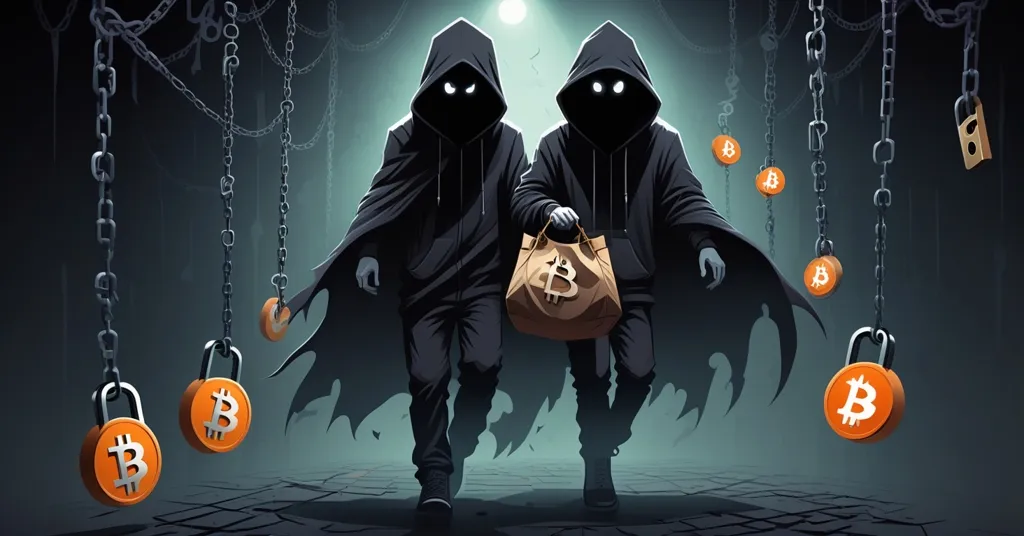Abacus Market Vanishes: Bitcoin Darknet Platform Suspected in Massive Exit Scam

Gone Without a Trace: Darknet Bitcoin Platform Abacus Market Vanishes in Suspected Scam
Abacus Market, a heavyweight Bitcoin-powered darknet marketplace in the Western sphere, has vanished without warning in early July 2024, leaving users high and dry and stoking fears of a massive exit scam. With millions in transactions at stake, this sudden shutdown raises hard questions about trust, risk, and the shadowy underbelly of cryptocurrency.
- Abacus Market Disappears: A top Bitcoin darknet platform goes offline, suspected of an exit scam after handling millions in illicit trades.
- Financial Freefall: Daily deposits crashed 95% from $230,000 to $13,000 in weeks.
- User Betrayal: Withdrawal failures and admin excuses point to foul play, shattering trust.
Abacus Market: From Dominance to Dust
In the hidden corners of the internet, accessible only through tools like Tor—a browser that masks your online activity by routing it through multiple global servers—darknet marketplaces (DNMs) thrive as hubs for illicit trade. Abacus Market stood as a titan among them, dealing in everything from drugs to stolen data, powered primarily by Bitcoin (BTC) and Monero (XMR). At its zenith in June 2024, it processed a staggering $6.3 million in monthly transactions, riding a wave of growth after competitors like ASAP Market, Incognito Market, and Archetyp Market fell. Over four years, Bitcoin sales alone neared $100 million, but when you add Monero—a privacy coin that hides transaction details through advanced tricks like ring signatures (think of it as shuffling money through a crowd so no one knows who gave what to whom)—total volume could hit $300 to $400 million. That’s a fortune built in the shadows, now apparently gone with the wind, as detailed in reports of Abacus Market vanishing without a trace.
For those new to this space, let’s break it down. Bitcoin transactions are pseudonymous, recorded on a public ledger where wallet addresses can be traced back to owners with enough effort through blockchain forensics—essentially digital detective work following crypto breadcrumbs. Monero, by contrast, obscures sender, receiver, and amount, making it a favorite for those dodging scrutiny. Abacus’s dual support for both reflected a darknet trend: while Bitcoin remains king for visibility and ease, Monero now drives up to 75% of DNM volume as users prioritize opacity. But no amount of tech could save Abacus from its abrupt end. For more background on platforms like this, check out this darknet marketplace overview.
Red Flags and User Fallout
Trouble started brewing in late June when users reported funds stuck in limbo—withdrawals failing with no clear reason. The platform’s admin, known only as “Vito,” offered flimsy excuses, pointing to a surge of new users after Archetyp’s seizure and a supposed DDoS attack, a cyber tactic akin to a mob blocking a shop door to halt business. According to blockchain analytics firm TRM Labs, Vito claimed the delays “won’t be for long.” Insights into these admin statements and withdrawal issues shed light on the unfolding chaos.
They were permanent, as it turns out.
Daily deposits, a barometer of user confidence, plummeted from $230,000 in early June to a pitiful $13,000 between June 28 and July 10—a 95% nosedive. That’s not just a red flag; it’s a flaming billboard screaming something’s wrong. Users on forums like Dread, a darknet hub for raw intel, vented fury over lost funds, with some estimating personal losses in the thousands. If even 1,000 users had $1,000 each locked in Abacus, that’s a cool million evaporated overnight. Imagine logging in to check your balance, only to face a blank screen—no warning, no recourse, just a void. It’s a brutal reminder of the risks in trusting centralized platforms, even in a space built on decentralized ideals, as discussed in community reactions on darknet forums.
Exit Scam or Silent Seizure? Theories Unpacked
The leading theory is an exit scam—Vito and crew likely grabbed what was left in the coffers and bolted. TRM Labs suggests after four years and profits hefty enough to buy a yacht or two, the operators chose “self-preservation over profit-seeking.” Becoming the biggest Bitcoin-powered DNM in the West, with over 70% market share post-competitor collapses, painted a target on their back. Past scams like Evolution Market in 2015, where admins vanished with $12 million in user Bitcoin, or Sheep Marketplace in 2013, which faked a hack to cover a $6 million theft, show a pattern: fake crises like DDoS attacks often mask an escape plan. Abacus fits this ugly mold, as evidenced in a detailed TRM Labs report on exit scam likelihood.
But there’s a flip side. Could law enforcement have pulled a stealth takedown? Modern agencies like the FBI or Europol often play the long game, silently seizing platforms to gather intel before publicizing—think Nemesis Market’s quiet fall. Using tools like Chainalysis, they track Bitcoin flows despite anonymity attempts, busting networks through operations like SpecTor, which nabbed hundreds of vendors across DNMs. Yet, insiders on Dread, including administrator Hugbunter who reportedly liaised with Abacus’s team, doubt a bust. No “site seized” banner or official statement supports this angle, leaving the scam theory dominant. Still, let’s play devil’s advocate: if authorities did strike, are users partly to blame for banking on centralized darknet hubs when crypto’s ethos is trustless systems? Curious minds can explore more on what happened to Abacus Market.
Darknet Trends: Bitcoin, Monero, and Shifting Sands
Zooming out, Abacus’s collapse is a snapshot of a volatile ecosystem. TRM Labs reports a 42% drop in new DNM launches in 2024 compared to last year, yet crypto-fueled drug sales spiked 19% to $2.4 billion. Fewer markets mean bigger players—until they crash. The pivot to Monero-only platforms, nearly half of 2024’s new DNMs, signals desperation for anonymity as Bitcoin’s traceability bites. Law enforcement adapts too, increasingly targeting vendors over platforms to choke supply chains. It’s a relentless cat-and-mouse game, and after Abacus, users and vendors are already flocking to successors like DrugHub, TorZon Market, and MGM Grand. Resilience, or recklessness? You decide. The broader context of recent darknet market closures in 2024 highlights the impact on Bitcoin transactions.
One curious detail: Abacus had a strong Australian following, weaving local slang and vendor support into its fabric. Was it catering to region-specific goods like precursor chemicals for local drug labs, or tapping into Aussie crime networks? This oddly corporate localization in a den of illegality shows even underground markets play to demographics, adding a layer of intrigue to its global footprint.
Bitcoin’s Double-Edged Sword and Crypto’s Future
Let’s cut to the chase: this mess stinks for Bitcoin’s reputation. Despite its traceability often aiding law enforcement—blockchain analysis has unmasked countless bad actors—Abacus’s heavy BTC usage cements crypto’s link to illicit trade in mainstream eyes. While institutional adoption grows with ETFs and corporate treasuries, stories like this fuel skepticism. It’s a harsh blow to the narrative of Bitcoin as future money, especially when privacy coins like Monero dominate actual darknet volume. As Bitcoin maximalists, we see BTC’s transparency as a strength for trust and legitimacy, but Monero’s role here is undeniable—it fills a niche of total opacity that Bitcoin shouldn’t touch. Freedom comes with baggage, and Abacus’s fall lays that duality bare, with deeper insights available on the broader impact of darknet scams on crypto reputation.
Looking ahead, what does this mean for crypto’s trajectory? Darknet scams could spur tighter regulation—think Monero bans over privacy fears or harsher KYC/AML rules on exchanges, impacting even legit Bitcoin users. Yet, user migration to new platforms mirrors crypto’s decentralized spirit—unstoppable, for better or worse. As champions of effective accelerationism, we push for adoption despite setbacks, but scams are poison. Trust remains crypto’s weak spot, and every exit scam chips at the dream of financial liberty. How do we balance unchecked freedom with accountability? That’s the million-Bitcoin question.
Key Takeaways and Questions on Abacus Market’s 2024 Shutdown
- What triggered Abacus Market’s disappearance in 2024?
Abacus Market, a leading Bitcoin darknet platform, went offline in July 2024, likely in an exit scam after raking in millions. A 95% deposit drop from $230,000 to $13,000 daily and withdrawal failures were glaring warnings. - Is an exit scam or law enforcement seizure more plausible?
An exit scam seems likely, with admins possibly fleeing with funds, though a covert seizure remains possible given modern tactics. Dread forum insiders lean toward scam, with no official bust confirmed. - How does this Bitcoin darknet scam impact crypto’s image?
Abacus’s Bitcoin reliance reinforces negative views in mainstream finance, despite BTC’s traceability aiding law enforcement. It clashes with growing institutional trust, complicating crypto’s acceptance. - Why is Monero overtaking Bitcoin in darknet trades?
Monero’s privacy features, hiding transaction details unlike Bitcoin’s public ledger, make it ideal for evading scrutiny, driving up to 75% of darknet volume as users prioritize anonymity. - What’s the broader fallout of darknet scams for crypto adoption?
Scams like Abacus erode trust, a major hurdle to mainstream uptake, underscoring the need for truly decentralized solutions and intensifying debates over regulation versus personal freedom. - Where are darknet users migrating post-Abacus?
Users and vendors are shifting to platforms like DrugHub and TorZon Market, highlighting the darknet’s stubborn adaptability despite frequent shutdowns and betrayals.
Abacus Market’s vanishing act isn’t just a loss for its users—it’s a stark lesson in the fragility of trust within centralized setups, even in a world built on decentralization. While we root for Bitcoin and blockchain to disrupt outdated systems, we can’t ignore the rot that festers in darknet scams. Yet, the relentless push to new platforms proves a core truth: the drive for autonomy, whether noble or nefarious, doesn’t bend easily. It’s a messy paradox—liberty and lawlessness often ride the same blockchain. Where we go from here depends on learning from these failures without losing sight of the revolutionary potential at crypto’s heart.



